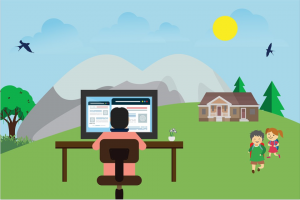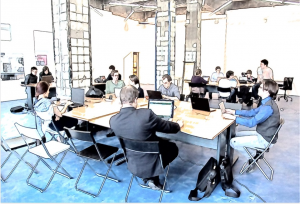Pandemic Work Reality is the most appropriate remedial process that provides a smooth transition in implementing back-to-full-operation procedures. Employment as we understand it has forever been changed by COVID-19. Now is the moment for administrators to visualize the office that workers will return to.
The world has experienced extensive interruption over the past year due to the COVID-19 pandemic. With the effective expansion and circulation of a COVID-19 vaccine, the period for when the alleged subsequently normal will appear is clearer. Leaders should start taking steps to think about what the workplace will look like afterward.
Companies and persons have discovered new ways of functioning. The majority have reported effectively realizing years’ worth of digital change plans for the past few months. Companies that required upholding an important collocated workplace use digital innovations to develop worker and client engagement and security. Managers should start asking themselves how they could develop such advancement to further change their companies instead of preparing for a return work that was becoming outdated even before the pandemic. Check out similar articles.
The pandemic is not the sole interruption we have encountered in the past year. It has also been a time of political division, social strife motivated by racial disparity, and current digital interruption, among others. Leaders should take the occasion to apply for the innovations and advances and develop a strategy for current workplace reinvention that is more flexible to all types of interruption.
Exploit The Merits Of Remote And Office Work
 The projected gradual return to the office offers chances to try out hybrid ways of working. Return to the office tactically, with a focus on the actions best done in person. In the process, evaluate the efficiency of both remote and office work. This gives administrators the capability to seriously consider how a hybrid workplace could be the most successful.
The projected gradual return to the office offers chances to try out hybrid ways of working. Return to the office tactically, with a focus on the actions best done in person. In the process, evaluate the efficiency of both remote and office work. This gives administrators the capability to seriously consider how a hybrid workplace could be the most successful.
The pandemic has taught us that remote work can be extremely successful to a certain degree. Workers are often more industrious when they don’t have to commute to work daily. On the other hand, virtual work allows individuals to work together across geographic, physical, as well as organizational boundaries. However, recent research indicates that the past few months of extensive remote working have also had some negative impacts as shown below:
1. Pandemic Work Reality | Initiating New Projects
 Remote work had a small impact on the ability of employees to finish large projects that were already in progress. Depending on virtual teamwork to start new projects, was more complicated in terms of drawbacks and stressors. This exposition emphasizes the worth of remote tasks but raises questions about depending on it completely for a long-term workplace approach. Check out how we help hotels achieve their objectives
Remote work had a small impact on the ability of employees to finish large projects that were already in progress. Depending on virtual teamwork to start new projects, was more complicated in terms of drawbacks and stressors. This exposition emphasizes the worth of remote tasks but raises questions about depending on it completely for a long-term workplace approach. Check out how we help hotels achieve their objectives
2. Pandemic Work Reality | Culture
Several respondents ascertaining and preserving managerial culture is complex, if not unfeasible, in virtual scenery. Many metrics of managerial culture provided by the physical workplace, such as the official dress code, disappear with virtual work. Hence, lack of a strong sense of culture is a principally severe problem in regards to inducting new employees.
3. Pandemic Work Reality | Mentoring And Coaching
 Younger employees received less mentoring and coaching during the move to remote work than they did ahead of the pandemic. If people don’t get the response they need to build up into more established employees and leaders. Therefore, this shortage could negatively impact their career progression over time.
Younger employees received less mentoring and coaching during the move to remote work than they did ahead of the pandemic. If people don’t get the response they need to build up into more established employees and leaders. Therefore, this shortage could negatively impact their career progression over time.
Leaders must spend the next few months strategizing how to merge the best features of remote and office work. Ben Waber, president of the workplace analytics company Humanyze, shared suggested that a little office work can reduce the limits of remote work. Workers who resumed office work for one or two days in a week improved the number of unexpected associations by about 25%, Waber said. On the other hand, we expect that decisions about complementing remote and office work will be affected by many factors. These include school reopening and public transport load, which have been affected by the pandemic.
Leaders ought to reflect on the following as they envisage the reinvented workplace:
a) Pandemic Work Reality | Enabling Flexibility In Usage
The pandemic has emphasized the significance of organizational nimbleness, and companies can design physical workplaces to support it. On the other hand, administrators should be mindful of worker preferences as they reorganize the configuration of space. Besides, office space configurations should be changed occasionally, perhaps with reduced workplace bulk during winter months to support employee health.
b) Pandemic Work Reality | Keep On Evolving Virtual Work
 Companies should keep on experimenting with virtual work in the middle of the steady return to the workplace. First, the majority of people have been functioning virtually for less than a year. While that quantity of time seems considerable, it is improbable that employers have revealed the full range of chances that virtual work offers during that period. For instance, the majority of companies are just starting to discover the potential benefits of more sophisticated asynchronous partnership tools. Besides, they are only scraping the outside on the countless ways of leveraging the data produced by the digital partnership to enhance workplace output.
Companies should keep on experimenting with virtual work in the middle of the steady return to the workplace. First, the majority of people have been functioning virtually for less than a year. While that quantity of time seems considerable, it is improbable that employers have revealed the full range of chances that virtual work offers during that period. For instance, the majority of companies are just starting to discover the potential benefits of more sophisticated asynchronous partnership tools. Besides, they are only scraping the outside on the countless ways of leveraging the data produced by the digital partnership to enhance workplace output.
Second, the nature of virtual work will transform when businesses can merge it with office work. Besides, companies can discover more intensely the procedures and practices that can develop virtual work to increase organizational benefits. For instance, the pandemic revealed significant on how companies formerly used digital apparatus. Managers who run hybrid meetings should try out new ways to encourage the inclusion of remote contributors. Check out similar blog posts.
c) Pandemic Work Reality | Support Office Work Digitally
If people have the alternative to work remotely, they are likely to use this time to engage either in personal focused work or in remote meetings. When workers endeavor to come back to the office, it will be to perform tasks that need in-person interactions. Digital apparatus can assist in maximizing in-person interactions by establishing office bearers at the same time. On the other hand, enhanced digitalization and analytics help improve the flow of organizational knowledge.
Whereas digital apparatus generate opportunities to work in new ways, companies should also consider the future. Besides, they should think about how these apparatus may be utilized to support alterations in staff behavior as tasks are automated. On the other hand, administrators should rethink how they administer output as more workers adopt a hybrid model with both remote and office work.
Discovering Workplace, Labor Force, and Tasks
 Discovering the workplace opens up new chances for rethinking the labor force and, eventually, tasks. When your organization is not restricted to an office workplace, the thought of whom you can incorporate in the workforce expands. For instance, Silicon Valley companies have said they can employ different people when their prospective talent pool is not restricted to those who live in the local area. This creates occasions for rethinking the task itself by developing new ways to incorporate automation and analytics to digitally change many work aspects.
Discovering the workplace opens up new chances for rethinking the labor force and, eventually, tasks. When your organization is not restricted to an office workplace, the thought of whom you can incorporate in the workforce expands. For instance, Silicon Valley companies have said they can employ different people when their prospective talent pool is not restricted to those who live in the local area. This creates occasions for rethinking the task itself by developing new ways to incorporate automation and analytics to digitally change many work aspects.
The Bottom-Line
The workplace, labor force, and tasks of the future will be essentially diverse as a result of the pandemic. The steady surfacing from this interruption offers an extraordinary chance to discover and try out. Persons in charge should learn to constantly reinvent the expectations of work, and now is the right time to start exploiting how to realize that future.
Reach out for our hospitality consultancy services Here
